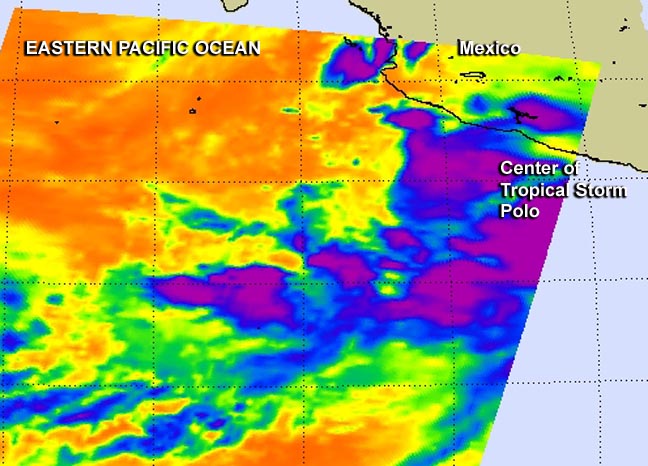NASA Sees Tropical Storm Polo Intensifying

NASA's Aqua satellite passed over Polo on Sept. 17 at 4:59 a.m. EDT and the Atmospheric Infrared Sounder instrument captured infrared data on the storm revealing bands of strong thunderstorms north and south of the center. Image Credit: NASA JPL, Ed Olsen
A Tropical Storm Warning is in force for the southwest coast of Mexico from Punta San Telmo to Playa Perula. A Tropical Storm Watch is in force from Punta San Telmo to Zihuatanejo and from Playa Perula to Cabo Corrientes.
Rainfall totals of 5 to 10, locally up to 15 inches, can be expected over coastal areas of Michoacan, Colima and Jalisco states in Mexico. Life-threatening flash-floods and mudslides could result.
Dangerous ocean swells from the tropical storm are expected to affect the coast of southern Mexico also causing rip-tides.
NASA's Aqua satellite passed over Polo on Sept. 17 at 4:59 a.m. EDT and the Atmospheric Infrared Sounder instrument captured infrared data on the storm revealing bands of strong thunderstorms north and south of the center.
At 11 a.m. EDT on Sept. 17, Polo's maximum sustained winds increased to near 60 mph (95 kph) and the storm is expected to become a hurricane tonight or early Thursday. The center of Tropical Storm Polo was located near latitude 15.7 north. and longitude 102.4 west.
Polo is moving toward the northwest near 10 mph (17 kph) and this motion is expected to continue for the next two days. The National Hurricane Center noted that on the forecast track the core of Polo will remain offshore of and move parallel to the southwestern coast of Mexico.
However, any deviation could bring stronger winds to the coast.
Polo is forecast to become a hurricane in a day or two.
Rob Gutro
NASA's Goddard Space Flight Center
Media Contact
More Information:
http://www.nasa.gov/content/goddard/polo-eastern-pacific/All latest news from the category: Earth Sciences
Earth Sciences (also referred to as Geosciences), which deals with basic issues surrounding our planet, plays a vital role in the area of energy and raw materials supply.
Earth Sciences comprises subjects such as geology, geography, geological informatics, paleontology, mineralogy, petrography, crystallography, geophysics, geodesy, glaciology, cartography, photogrammetry, meteorology and seismology, early-warning systems, earthquake research and polar research.
Newest articles

High-energy-density aqueous battery based on halogen multi-electron transfer
Traditional non-aqueous lithium-ion batteries have a high energy density, but their safety is compromised due to the flammable organic electrolytes they utilize. Aqueous batteries use water as the solvent for…

First-ever combined heart pump and pig kidney transplant
…gives new hope to patient with terminal illness. Surgeons at NYU Langone Health performed the first-ever combined mechanical heart pump and gene-edited pig kidney transplant surgery in a 54-year-old woman…

Biophysics: Testing how well biomarkers work
LMU researchers have developed a method to determine how reliably target proteins can be labeled using super-resolution fluorescence microscopy. Modern microscopy techniques make it possible to examine the inner workings…





















